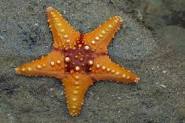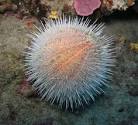
Well, not exactly hedgehogs, but hedgehog skins to be precise. This is the translation of the Latin name Echinoderm which covers starfish and sea urchins.
Coastwise heard all about this group of animals, which is so distinctive that it occupies its own taxonomic phylum, from Holly Morgenroth, Curator of Natural History at Exeter Museum.

One curious charateristic of starfish is autotonomy, or the ability to discard a limb for either escape or reprooduction. Other animals are able to do this, but although they can regenerate the limb, none except the starfish can do the reverse, that is, generating a new body from the discarded limb.
Echinoids, or sea urchins, have existed in the fossil record aince pre-Cambrian times, and by 500Mya had become common in their current form. The Victorian naturalist Gosse described them  very elegantly, referring to the hard and muscular feeding parts as Aristotle's Lantern. Starfish don't have the same hard mouths, but are able to extrude their stomachs to envelop prey and digect it gradually.
very elegantly, referring to the hard and muscular feeding parts as Aristotle's Lantern. Starfish don't have the same hard mouths, but are able to extrude their stomachs to envelop prey and digect it gradually.
The exhibition at Exeter is very lucky to have a substantial amount of material from the ground-breaking HMS Challenger expedition of the 1870s, which applied serious scientific resource and method to the oceans over a 4-year voyage covering over 70,000 nautical miles. Exeter Museum has over 300 of the specimens.

